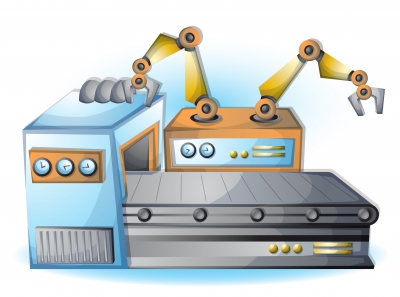 Image courtesy of toonsteb at FreeDigitalPhotos.net
Image courtesy of toonsteb at FreeDigitalPhotos.net
India has the potential to become the hotbed of next generation manufacturing technology that integrates the digital and the physical world (also called Industry 4.0). The push for growing the manufacturing sector from its current contribution of around 16 percent as share of GDP to around 25 percent of GDP by 2025 through programs like Make in India, should be accompanied by an equal if not a larger push within the IT services industry with the demands of next generation manufacturing techniques.
According to CII, the manufacturing sector currently employs 12% of our population and has the potential to create another 90 million jobs by 2025 . Against the backdrop of rising global protectionism and a move to bring back manufacturing jobs to advanced economies, Indian manufacturing would need to focus significantly on improving its competitiveness, efficiency and productivity, while leveraging domestic advantages such as its large engineering talent pool and relatively lower cost of labor. If Indian manufacturing is to reap the benefits of the country’s demographic dividend and see a significant increase in manufactured exports (in particular high-technology goods) to boost overall GDP growth, the increase in productivity and competitiveness would have to come through massive investments in digitization, R&D as well as well investment in skills development to prepare the labor force for next generation manufacturing. Instead of focusing on traditional manufacturing, a focus on next generation manufacturing techniques that will leverage our competence in software can help the Indian economy differentiate itself from other countries that have similar labour cost advantages. Given the recent push for growth in the manufacturing sector, domestic manufacturing firms looking to compete on a global stage should drive demand for IT services.
Software companies can render their services to domestic manufacturing sectors by connecting the physical and digital world through next generation manufacturing techniques. This is a huge opportunity for the Indian IT industry especially at a time when there is decreased spending on IT services from traditional cash cows like banking and financial services and the possibility of increased visa restrictions overseas. The good news is that Indian IT firms seem to be developing some of these technologies in-house, collaborating and investing in Industry 4.0 focused companies with the idea of integrating next generation manufacturing into their current IT service offerings.
The within the Indian manufacturing firm has to then increasingly shift towards moving up the value chain by digitizing their business through technologies like cyber-physical systems, the internet of things and cloud computing. Bringing in the accuracy and speed of the digital world into conventional manufacturing can help bring down costs and increase revenues thus helping make the manufacturing sector more productive and efficient. An example would be the use of sensors and predictive analytics to perform scheduled maintenance of equipment as a result of which machine downtime is significantly reduced.
A 2015 survey by PWC has shown that digitization in manufacturing is gathering steam among companies across the globe with 33% of their respondent companies saying they have achieved high levels of digitization in industrial production today. As highlighted in recent articles in the print media, industrial giants like GE, Bosch and Siemens realize the potential short and long term impact that advanced manufacturing techniques could have on their business and have active initiatives that have been trying to incorporate these technologies into their current setup In India, ‘Make in India’ campaign has been centered around boosting manufacturing across sectors and there has been some talk of adoption of ‘Industry 4.0’ into the Make in India framework.
While many next generation manufacturing techniques have so far been used in advanced economies that have labour shortages and an aging workforce, they will need to be adapted for India where 65% of the population is under the age of 35. Keeping the future in sight, skill development programs should integrate digital technologies into their curriculum and those in the workforce may need to be reskilled to operate increasingly “digital” equipment. At the same time management at manufacturing firms will need to think long-term and make bold investment decisions to move their firms into the digital age. With the right policies at the macro level combined with firm level investments that leverage India’s IT prowess, Indian manufacturing can leapfrog to the next generation while effectively leveraging our demographic dividend.
[1] https://www.ibef.org/industry/manufacturing-sector-india.aspx
[2] http://www.cii.in/sectors.aspx?enc=prvePUj2bdMtgTmvPwvisYH+5EnGjyGXO9hLECvTuNsfVm32+poFSr33jmZ/rN+5
[3]https://www.infosys.com/newsroom/press-releases/Pages/establishing-industry4-0-partnership.aspx
[4]http://businessworld.in/article/How-Digital-Can-Transform-Manufacturing/19-12-2016-110004/
[6] https://www.strategy-business.com/article/A-Strategists-Guide-to-Industry-4.0?gko=7c4cf
[7] http://www.makeinindia.com/article/-/v/towards-smart-manufacturing-industry-4-0-and-india